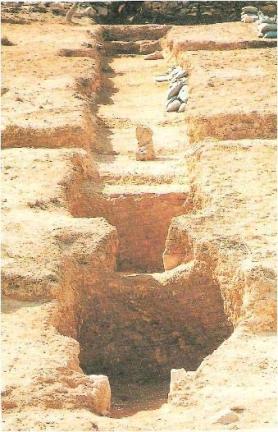고흥 운대리 도요지
| 고흥 운대리 도요지 Kiln Site in Undae-ri, Goheung |
|
 고흥 운대리 도요지, 국가문화유산포털, 문화재청. |
|
| 대표명칭 | 고흥 운대리 도요지 |
|---|---|
| 영문명칭 | Kiln Site in Undae-ri, Goheung |
| 한자 | 高興 雲垈里 陶窯址 |
| 주소 | 전라남도 고흥군 두원면 운대리 산 130 일원 |
| 지정(등록) 종목 | 전라남도 기념물 제80호 |
| 지정(등록)일 | 1985년 2월 15일 |
| 분류 | 유적건조물/산업생산/요업/도자기가마 |
| 수량/면적 | 27,179㎡ |
| 웹사이트 | 고흥 운대리 도요지, 국가문화유산포털, 문화재청. |
|
|
|
해설문
국문
운대리 도요지는 통일신라시대 말부터 조선시대까지 청자와 분청사기를 만들던 가마터가 집중적으로 분포하고 있는 유적지이다. 운대저수지를 중심으로 운곡마을 양옆 구릉의 두원천 주변에 청자 가마터 5곳과 분청사기 가마터 25곳 등 모두 30곳의 가마터가 있다.
청자 가마터에서는 청자와 암갈색과 흑갈색 유약을 입힌 흑자 등의 자기류와 갑발, 갑발 받침 등의 제작도구가 출토되었다. 청자의 경우 대접, 접시, 완, 종지 등 소형 그릇이 많은 데 비해 흑자는 병, 항아리, 주자 등 대형이 많아 용도에 따라 다양한 자기를 만들었던 것으로 보인다. 특히 초기 청자 형식인 해무리굽 청자는 굽 안쪽이 둥글게 깎인 것부터 평평한 것까지 여러 종류가 다량 발견되어 초기 청자의 변화 과정을 보여준다. 갑발은 도자기를 구울 때 가마 안의 이물질이나 재가 떨어지는 것을 막고 일정한 온도를 유지하기 위해 사용하는 큰 그릇으로, 이곳에서 최상품의 청자를 제작했다는 것을 시사한다.
분청사기 가마터에서는 인화, 상감, 조화, 박지, 귀얄, 덤벙, 철화 등 분청사기에서 확인되는 모든 기법의 분청사기가 출토되었다. 특히 덤벙과 귀얄 기법을 사용한 분청사기가 집중적으로 제작되었던 것으로 보인다. 발견된 그릇의 종류는 대접, 접시, 잔, 병, 항아리, 단지, 장군, 벼루 등이며, 대접과 접시 같은 일상생활 용기가 주를 이룬다. 갑발은 발견되지 않았으며, 모래받침과 같은 도구를 사용해 구운 것으로 보인다.
30곳의 가마 중 발굴조사가 완료된 1호와 2호 가마는 2011년 ‘고흥 운대리 분청사기 요지’라는 명칭의 사적 제519호로 지정되었다. 이곳은 산기슭의 자연 경사면을 이용한 단실 오름가마로 15세기에 분청사기를 제작하는 데 사용되었다, 우리나라 최남단의 위치한 분청사기 요지이며, 분청사기의 특성과 변천 과정을 밝히는 데 중요한 자료를 제공한다.
영문
Kiln Site in Undae-ri, Goheung
Located among the hills surrounding Ungok Village in Goheung, these are the sites of 32 kilns used for the production of celadon and buncheong ware from the end of the Unified Silla period (668-935) to the Joseon period (1392-1910). Five of the kilns were used in the production of celadon glazed in not only the customary jade green hue, but also in dark brown or blackish-brown hues. The other 27 kilns produced buncheong ware, which is a type of traditional ceramic originating in Korea in which celadon is coated with white slip and decorated.
At the celadon kiln sites, a variety of items were produced depending on the intended use. The majority of the green-glazed wares were small vessels such as various bowls, dishes, and saucers, whereas the majority of the black-glazed wares were larger vessels such as bottles, jars, and ewers. A large quantity of early-period celadon bowls with a halo-shaped foot was discovered on the site. These bowls display a variety of foot styles, which give insight into how celadon production changed over time. Celadon production tools, such as saggars and saggar stands, were also discovered. A saggar is a large ceramic container used to protect pottery from contaminants such as falling ash and to keep a uniform baking temperature. The saggars found at these celadon kiln sites suggest that the pottery produced here was of high quality.
At the buncheong ware kiln sites, examples of all of the various buncheong ware decorative techniques were discovered, including stamped, inlaid, incised, sgraffito, and decorated in underglaze iron, with an apparent specialization in the brushed-with-white-slip and dipped-in-white-slip techniques. The majority of the buncheong ware were everyday items, such as bowls, dishes, cups, bottles, small and large jars, barrel-shaped vessels, and inkstones. No saggars were found at the buncheong ware kilns, suggesting that the pottery was placed on a sand base for firing.
Among the 32 kiln sites discovered, Buncheong Kiln Sites No. 1 and No. 2 were designated in 2011 as a Historic Site under the name “Buncheong Kiln Site in Undae-ri, Goheung.” The two kilns are climbing kilns, built into the natural sloping terrain at the foot of the hill. They were used in the 15th century for the production of buncheong ware and are the southernmost buncheong ware kilns discovered on the Korean Peninsula. Both are considered a valuable source of information on characteristics and the history of buncheong ware production.
영문 해설 내용
고흥 운곡마을 양옆 구릉에는 통일신라시대 말부터 조선시대까지 청자와 분청사기를 만들던 총 32기의 가마터가 분포하고 있다. 5곳의 청자 가마에서는 청자와 암갈색과 흑갈색 유약을 입힌 흑자 등이 생산되었고, 나머지 27기의 가마에서는 청자에 백토로 분을 발라 다시 구워낸 한국 고유의 자기인 분청사기가 생산되었다.
청자 가마터에서는 용도에 따라 다양한 그릇이 생산되었다. 청자 대부분은 대접, 접시, 종지 등 소형 그릇이 많은 데 비해, 흑자는 병, 항아리, 주자 등 대형이 많다. 특히 초기 청자 형식인 해무리굽 청자는 굽 안쪽이 둥글게 깎인 것부터 평평한 것까지 여러 종류가 다량 발견되어 초기 청자의 변화 과정을 보여준다. 갑발, 갑발 받침 등의 제작도구도 함께 출토되었다. 갑발은 도자기를 구울 때 가마 안의 이물질이나 재가 떨어지는 것을 막고 일정한 온도를 유지하기 위해 사용하는 큰 그릇으로, 이곳에서 최상품의 청자를 제작했다는 것을 시사한다.
분청사기 가마터에서는 인화, 상감, 조화, 박지, 귀얄, 덤벙, 철화 등 분청사기에서 확인되는 모든 기법의 분청사기가 출토되었다. 특히 덤벙과 귀얄 기법을 사용한 분청사기가 집중적으로 제작되었던 것으로 보인다. 발견된 그릇의 종류는 대접, 접시, 잔, 병, 항아리, 단지, 장군, 벼루 등이다. 갑발은 발견되지 않았으며, 모래받침과 같은 도구를 사용해 구운 것으로 보인다.
32곳의 가마 중 발굴조사가 완료된 분청사기 가마 1호와 2호는 2011년 ‘고흥 운대리 분청사기 요지’라는 이름으로 사적으로 지정되었다. 이 두 가마는 산기슭의 자연 경사면을 이용한 오름가마이며, 15세기에 분청사기를 제작하는 데 사용되었다, 한반도 최남단의 위치한 분청사기 요지이며, 분청사기의 특성과 변천 과정을 밝히는 데 중요한 자료를 제공한다.
참고자료
- 『고흥 운대리 도요지 정밀지표조사 보고서』, 국립광주박물관, 고흥군, 2002.
- 『고흥 운대리 분청사기 도요지』, 국립광주박물관, 고흥군, 2002.
- 『한국고고학전문사전 – 생산유적편』, 국립문화재 연구소, 2019, 1072~1074쪽.
- 고흥 운대리 도요지, 국가문화유산포털, 문화재청. http://www.heritage.go.kr/heri/cul/culSelectDetail.do?ccbaCpno=2333600800000
- 고흥 운대리 분청사기 요지, 국가문화유산포털, 문화재청. http://www.heritage.go.kr/heri/cul/culSelectDetail.do?ccbaCpno=1333605190000
- 고흥운대리도요지, 한국민족문화대백과사전, 한국학중앙연구원. http://encykorea.aks.ac.kr/Contents/Item/E0004083
- 「고흥 운대리 분청사기 요지」 사적 지정, 문화재청 보도자료, 2011.12.23. http://www.cha.go.kr/newsBbz/selectNewsBbzView.do?newsItemId=155697175§ionId=b_sec_1&pageIndex=1&strWhere=&strValue=&mn=NS_01_02